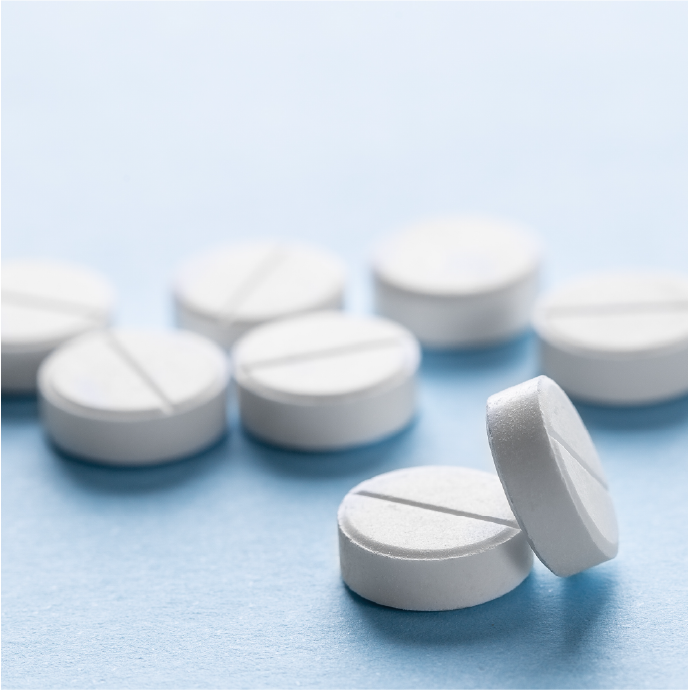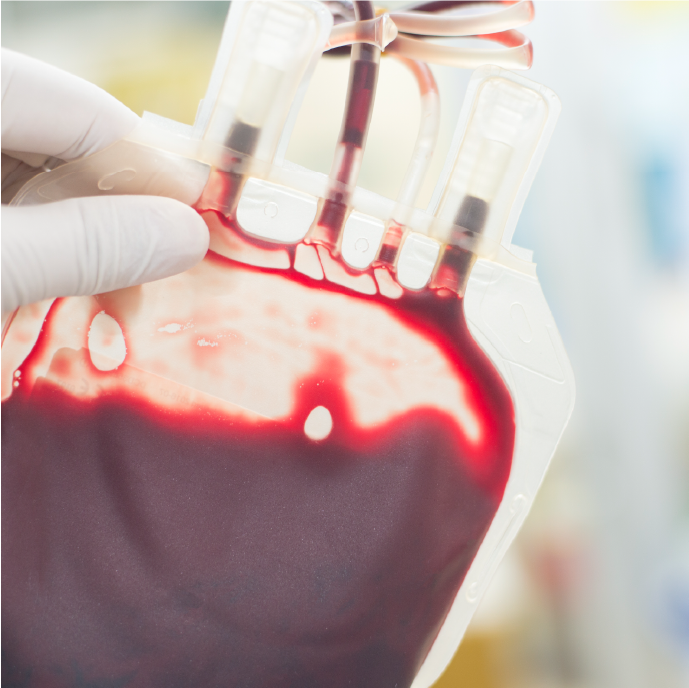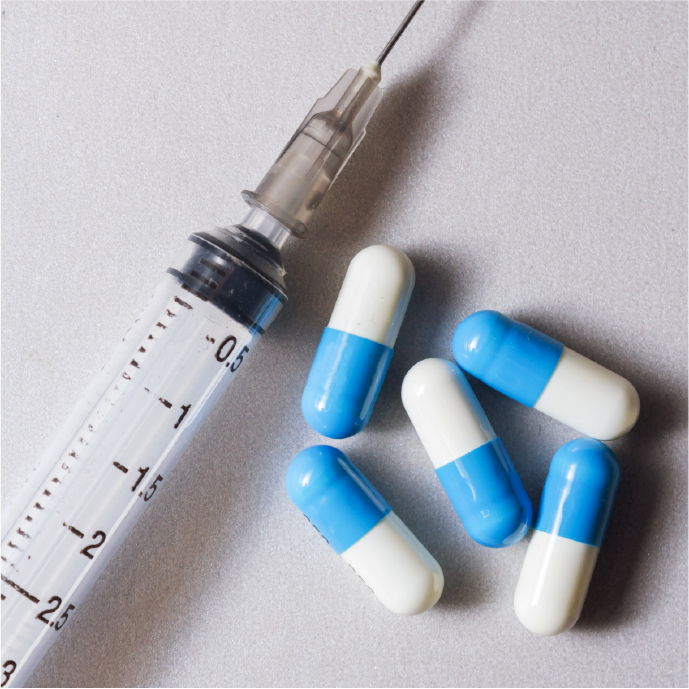This content is intended for UK healthcare professionals only and has been developed and funded by
Prescribing information (hosted externally) › Adverse event reporting information ›The treatment landscape
for polycythaemia vera
JAKAVI® (ruxolitinib) is indicated for the treatment of adult patients with polycythaemia vera who are resistant to or intolerant of hydroxyurea (also referred to as hydroxycarbamide in the UK).1

First-line treatment options for polycythaemia vera2

Antithrombotics
Antiplatelet
therapy with
low‑dose aspirin2,3
Aspirin is not licensed for use in PV.

Phlebotomy
(venesection)2,3

HIGH-RISK PATIENTS2-5
Cytoreductive therapies:2-5*
- Hydroxyurea (HU)†
- IFN‑alfa
- PegIFN‑alfa
- RopegIFN alfa-2b
Not all forms of interferon therapy are licensed for use in PV.
*Cytoreductive therapies may be considered for low-risk patients with
progressively
increasing splenomegaly or leucocyte and platelet counts, and those who do not tolerate phlebotomy.8
†HU should be used with caution in younger patients (aged <40 years).3
Antiplatelet therapy: aspirin
The ELN guideline recommends all eligible patients with PV should be managed with low‑dose aspirin3
Aspirin is not licensed for use in PV.
- Aspirin reduces the rate of platelet formation in artery walls2
- The ECLAP study (N=518) showed that aspirin significantly lowered the risk of the primary composite endpoint of CV death, non-fatal MI, non-fatal stroke and major VTE versus placebo9‡
- Adverse events include bleeding, gastric intolerance and heartburn2,10
Anticoagulant medications
- A 2015 study demonstrated that anticoagulant (VKA) treatment reduced risk of thrombotic recurrence without a significant effect on major bleeding, compared with no VKA11
- Nevertheless, major bleeding remains a possible adverse event and a clinical risk that must be factored into decision‑making12
‡European Collaboration on Low-Dose Aspirin in Polycythemia Vera (ECLAP) was a double‑blind, placebo‑controlled, randomised clinical study evaluating the efficacy and safety of prophylactic low‑dose aspirin in patients with PV. Patients without a clear indication or contraindications to aspirin were enrolled (N=518); the median age was 61 years and the mean duration of follow‑up was about 3 years. Aspirin significantly lowered the risk of a primary composite endpoint, including CV death, non‑fatal MI, non‑fatal stroke and major VTE, versus placebo (3.2% vs 7.9%; relative risk: 0.40; 95% CI: 0.18‑0.91; p=0.03). The rate of major bleeding events was not significantly different for aspirin versus placebo (1.2% vs 0.8%; relative risk: 1.62; 95% CI: 0.27‑9.71). Low‑dose aspirin remains standard therapy for all patients with PV.9
All eligible patients with PV should be managed with phlebotomy together with daily low dose aspirin3,13
- Targeting HCT <45% reduces thrombosis risk and is recommended by the ELN and BSH guidelines5,13
- A volume of blood is drawn at regular intervals - initially every other day or twice per week, until the haematocrit target is reached10,14
Cytoreductive therapies
Cytoreductive therapies should be considered for high-risk patients with PV (aged ≥60 years and/or history of PV‑related thrombosis) and may also be considered for low‑risk patients (any age):13,17
- with progressively increasing splenomegaly
- with progressively increasing leucocyte and platelet counts
- who do not tolerate phlebotomy

About hydroxyurea (HU)
- Targets multiple areas of haematologic overproduction by inhibiting ribonucleotide reductase, which prevents DNA synthesis5,10
- May reduce HCT concentration and platelet count2
-
Is the most commonly used first‑line cytoreductive therapy in patients
with PV18
- In the PVSG study (N=51), HU was compared retrospectively with phlebotomy alone in 194 patients. HU led to a reduction in thrombotic events (9.8% vs 32.8% in the phlebotomy group; p=0.009)18
- Hydroxyurea should be used with caution in younger patients13
Adverse events
Adverse events include, but are not limited to, macrocytosis, myelosuppression, ulceration in perimalleolar areas, oral aphthous ulceration, actinic keratosis, squamous cell cancer and other skin lesions, as well as gastrointestinal side effects.5
Intolerance and resistance
- Although HU is generally well tolerated,5 intolerance may affect 1 in 8 people19
- 1 in 9 patients
develop resistance to HU19
- Resistance to HU is associated with an approximately 5.6-fold increase in risk of death (95% CI: 2.7-11.9; p<0.001)19
- Monitoring resistance and intolerance criteria is important to inform when a change of therapy is needed19,20

Adverse events and tolerability
- Adverse events include flu-like symptoms, fatigue, depression, musculoskeletal pain, changes in mood, anxiety, injection site reaction, gastrointestinal toxicity (nausea, vomiting, diarrhoea) and weight loss21


About pegIFN‑alfa
- Modified IFN with PEG chain attached, with a longer half-life than IFN‑alfa22
- Less frequent administration and better tolerability versus IFN‑alfa (latter applies to pegIFN‑alfa-2a)5,23
- Has demonstrated efficacy in normalising myeloproliferation and preventing thrombosis3
- Off-label in patients with PV that are intolerant or resistant to hydroxyurea22
Adverse events and tolerability
- The most frequent grade 3 or 4 toxicity with pegIFN‑alfa-2a is neutropenia. Other adverse events reported include infection, diarrhoea, depression and elevated liver function tests23
- PegIFN‑alfa-2b shares similarities with unmodified IFN‑alfa;21 side effects include fatigue, injection site reaction, flu-like symptoms, headache, myalgia, depression, insomnia, alopecia and weight loss24


About ropegIFN alfa‑2b
- Indicated as monotherapy in adults with PV without symptomatic splenomegaly26
- May be considered more frequently for younger patients27
- Has
demonstrated
complete haematological responses in 71% of patients with PV and sustained
reductions (19.7%)
in mutation burden of JAK2 V617F from baseline5,26
- An open-label, phase IIIb extension study (CONTINUATION-PV) enrolled 171 adult patients with PV who previously completed the PROUD-PV study to evaluate the long-term efficacy and safety of ropegIFN alfa-2b. 95 patients continued to receive ropegIFN alfa-2b (from 50-500 mcg administered subcutaneously every 2, 3 or 4 weeks). The mean dose after 36 months of treatment (12-month treatment duration in the PROUD-PV study and 24-month treatment duration in the extension study) was 363 (±149) mcg for ropegIFN alfa-2b26
Adverse events and tolerability
- The most common adverse reactions include leukopenia, thrombocytopenia, arthralgia, fatigue, increased gamma-glutamyltransferase, flu-like illness, myalgia, pyrexia, pruritus, increased alanine aminotransferase, anaemia, pain in extremity, alopecia, neutropenia, increased aspartate aminotransferase, headache, diarrhoea, chills, dizziness and injection site reaction26

Symptom-directed therapies
Pruritus
Patients with PV can suffer from aquagenic pruritus, a debilitating condition characterised by strong itching, stinging, tingling or burning sensations upon contact with water without visible changes to the skin:29
- Antihistamines can be used but are largely ineffective10
- Topical agents such as cooling cream, lidocaine cream, capsaicin or corticosteroids may be helpful7
- Patients can try to reduce discomfort by lubricating the skin and minimising bathing7
Splenomegaly
Splenic irradiation
- Splenic irradiation is a palliative treatment for symptoms resulting from splenomegaly, especially discomfort and mechanical symptoms3,30
- The procedure is typically reserved for patients who are unable to undergo splenectomy30
- Adverse events include increased haemoglobin levels and decreased WBC counts31
BSH: British Society for Haematology; CI: confidence interval; CV: cardiovascular; ELN: European LeukemiaNet; HCT: haematocrit; HR: hazard ratio; IFN: interferon; MI: myocardial infarction; PV: polycythaemia vera; PVSG: Polycythemia Vera Study Group; RBC: red blood cell; ropegIFN: ropeginterferon; VKA: vitamin K antagonist; VTE: venous thromboembolism; WBC: white blood cell
Adverse events should be reported. Reporting forms and information can be found at www.mhra.gov.uk/yellowcard. Adverse events should also be reported to Novartis online through the pharmacovigilance intake (PVI) tool at www.novartis.com/report or alternatively email medinfo.uk@novartis.com or call 01276 698370
References
- JAKAVI® Summary of Product Characteristics. Available at: medicines.org.uk.
- Leukemia and Lymphoma Society. Polycythemia vera facts. Available at: lls.org. [Accessed August 2025].
- Barbui T, Barosi G et al. Philadelphia-negative classical myeloproliferative neoplasms: critical concepts and management recommendations from European LeukemiaNet. J Clin Oncol 2011;29(6):761-770.
- Gisslinger H, Klade C et al. Evidence for superior efficacy and disease modification after three years of prospective randomized controlled treatment of polycythemia vera patients with ropeginterferon alfa-2b vs HU/BAT. Blood 2018;132:579.
- McMullin M F, Harrison C N et al. A guideline for the diagnosis and management of polycythaemia vera. A British Society for Haematology Guideline. Br J Haematol 2019;184(2):176-191.
- NHS. Itchy skin. Available at: nhs.uk. [Accessed August 2025].
- Seccareccia D, Gebara N. Pruritus in palliative care: getting up to scratch. Can Fam Physician 2011;57(9):1010-1013, e1316-1019.
- Arya Y, Syal A et al. Advances in the treatment of polycythemia vera: trends in disease management. Cureus 2021;13(3):e14193.
- Landolfi R, Marchioli R et al. Efficacy and safety of low-dose aspirin in polycythemia vera. N Engl J Med 2004;350(2):114-124
- Passamonti F. How I treat polycythemia vera. Blood 2012;120(2):275-284.
- Hernandez-Boluda J C, Arellano-Rodrigo E et al. Oral anticoagulation to prevent thrombosis recurrence in polycythemia vera and essential thrombocythemia. Ann Hematol 2015;94(6):911-918.
- Kaifie A, Kirschner M et al. Bleeding, thrombosis, and anticoagulation in myeloproliferative neoplasms (MPN): analysis from the German SAL‑MPN-registry. J Hematol Oncol 2016;9:18.
- Barbui T, Tefferi A et al. Philadelphia chromosome-negative classical myeloproliferative neoplasms: revised management recommendations from European LeukemiaNet. Leukemia 2018;32(5):1057-1069.
- Marchioli R, Finazzi G et al. Cardiovascular events and intensity of treatment in polycythemia vera. N Engl J Med 2013;368(1):22-33.
- Najean Y, Dresch C, Rain J D. The very-long-term course of polycythaemia: a complement to the previously published data of the Polycythaemia Vera Study Group. Br J Haematol 1994;86(1):233-235.
- Alvarez-Larran A, Perez-Encinas M et al. Risk of thrombosis according to need of phlebotomies in patients with polycythemia vera treated with hydroxyurea. Haematologica 2017;102(1):103-109.
- Marchetti M, Vannucchi A M et al. Appropriate management of polycythaemia vera with cytoreductive drug therapy: European LeukemiaNet 2021 recommendations. Lancet Haematol 2022;9(4):e301-e311.
- Griesshammer M, Kiladjian J J, Besses C. Thromboembolic events in polycythemia vera. Ann Hematol 2019;98(5):1071-1082.
- Alvarez-Larran A, Pereira A et al. Assessment and prognostic value of the European LeukemiaNet criteria for clinicohematologic response, resistance, and intolerance to hydroxyurea in polycythemia vera. Blood 2012;119(6):1363-1369.
- Barosi G, Birgegard G et al. A unified definition of clinical resistance and intolerance to hydroxycarbamide in polycythaemia vera and primary myelofibrosis: results of a European LeukemiaNet (ELN) consensus process. Br J Haematol 2010;148(6):961-963.
- Nazha A, Gerds A T. Where to turn for second-line cytoreduction after hydroxyurea in polycythemia vera? Oncologist 2016;21(4):475-480.
- PegIFN‑alfa Summary of Product Characteristics.
- Quintas-Cardama A, Kantarjian H et al. Pegylated interferon alfa-2a yields high rates of hematologic and molecular response in patients with advanced essential thrombocythemia and polycythemia vera. J Clin Oncol 2009;27(32):5418-5424.
- Samuelsson J, Hasselbalch H et al. A phase II trial of pegylated interferon alpha-2b therapy for polycythemia vera and essential thrombocythemia: feasibility, clinical and biologic effects, and impact on quality of life. Cancer 2006;106(11):2397-2405.
- Mascarenhas J, Mesa R et al. Optimal therapy for polycythemia vera and essential thrombocythemia can only be determined by the completion of randomized clinical trials. Haematologica 2014;99(6):945-949.
- Ropeginterferon alfa-2b Summary of Product Characteristics .
- Benevolo G, Vassallo F et al. Polycythemia vera (PV): update on emerging treatment options. Ther Clin Risk Manag 2021;17:209-221.
- Gisslinger H, Klade C et al. Ropeginterferon alfa-2b versus standard therapy for polycythaemia vera (PROUD-PV and CONTINUATION-PV): a randomised, non-inferiority, phase 3 trial and its extension study. Lancet Haematol 2020;7:e196-e208
- Siegel F P, Tauscher J, Petrides P E. Aquagenic pruritus in polycythemia vera: characteristics and influence on quality of life in 441 patients. Am J Hematol 2013;88(8):665-669.
- Logan M S, Watson C M, Nottingham J M. Symptomatic splenomegaly in polycythemia vera: a review of the indications for splenectomy and perioperative considerations. Am Surg 2009;75(5):363-368.
- Nazmy M S, Radwan A, Mokhtar M. Palliative spleen irradiation: can we standardize its technique? J Egypt Natl Canc Inst 2008;20(1):31-35.






